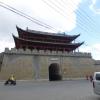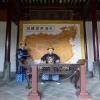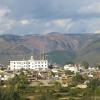Billed as "the largest Confucian temple in Southern China", Jianshui's temple was founded in 1285, during the Yuan Dynasty, although the existing buildings date mostly to the late 18th century (and probably have been heavily restored in the late 20th). Unlike its better known namesakes in Qufu or Hanoi, Jianshui's temple includes a large lake, known as Xuehai ("The Sea of Learning"). A pavilion on the island is called Si Le Ting 思乐亭, i.e. the "Joy of Learning Pavilion"; it's also know under the alternative name, "Diao Ao Ting", i.e. "The pavilion for catching Ao"; catching Ao, a legendary giant sea turtle, is a metaphor for scoring best at the traditional civil service examination in the Imperial China. Similar to the Confucian temples elsewhere, Jianshui's temple has a large assortment of ornate gates and halls for honoring Confucius, his ancestors and disciples, and assorted local worthies, in a parklike setting, among cypress trees. If you've been to Qufu or Hanoi, you'll notice one difference, though: in Qufu or Hanoi, most important stone tablets are mounted on top of stone tortoises (bixi), while in Jianshui, there is not a tortoise in sight; on the other hand, elephant motif is prominent in decorating the temple in Jianshui.
Entry fee: ¥60.
Activities near Temple of Confucius
Long before Americans started studying for SAT, GRE, and bar exams, a system of local, provincial, and imperial examinations served
Qingyuan Gate is the main entrance to Jianshui Ancient Town, a historic site in Honghe Prefecture of Yunnan Province. The
Jianshui, an ancient town in Honghe Prefecture of Yunnan Province, is one of the national famous historic and cultural towns
The southern gate of Jianshui Ancient Town
The preserved eastern gate of the Lin'an city wall, now standing in the middle of a traffic roundabout. It is
On a hill south of town, this early 19th-century structure is meant to resemble a writing brush, although to a
If you are looking for a stunning sight in Jianshui County, Honghe, you should definitely visit the Double Dragon Bridge
If you love nature and adventure, you should definitely visit the Swallow Cave in Honghe, Miandian. It is one of
Guanyi village is a hidden gem in the Honghe region of Yunnan province, China. It is home to the Hani









